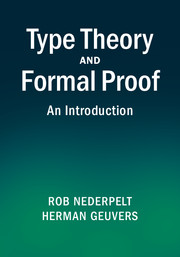Book contents
- Frontmatter
- Contents
- Foreword
- Preface
- Acknowledgements
- Greek alphabet
- 1 Untyped lambda calculus
- 2 Simply typed lambda calculus
- 3 Second order typed lambda calculus
- 4 Types dependent on types
- 5 Types dependent on terms
- 6 The Calculus of Constructions
- 7 The encoding of logical notions in λC
- 8 Definitions
- 9 Extension of λC with definitions
- 10 Rules and properties of λD
- 11 Flag-style natural deduction in λD
- 12 Mathematics in λD: a first attempt
- 13 Sets and subsets
- 14 Numbers and arithmetic in λD
- 15 An elaborated example
- 16 Further perspectives
- Appendix A Logic in λD
- Appendix B Arithmetical axioms, definitions and lemmas
- Appendix C Two complete example proofs in λD
- Appendix D Derivation rules for λD
- References
- Index of names
- Index of definitions
- Index of symbols
- Index of subjects
8 - Definitions
Published online by Cambridge University Press: 05 November 2014
- Frontmatter
- Contents
- Foreword
- Preface
- Acknowledgements
- Greek alphabet
- 1 Untyped lambda calculus
- 2 Simply typed lambda calculus
- 3 Second order typed lambda calculus
- 4 Types dependent on types
- 5 Types dependent on terms
- 6 The Calculus of Constructions
- 7 The encoding of logical notions in λC
- 8 Definitions
- 9 Extension of λC with definitions
- 10 Rules and properties of λD
- 11 Flag-style natural deduction in λD
- 12 Mathematics in λD: a first attempt
- 13 Sets and subsets
- 14 Numbers and arithmetic in λD
- 15 An elaborated example
- 16 Further perspectives
- Appendix A Logic in λD
- Appendix B Arithmetical axioms, definitions and lemmas
- Appendix C Two complete example proofs in λD
- Appendix D Derivation rules for λD
- References
- Index of names
- Index of definitions
- Index of symbols
- Index of subjects
Summary
The nature of definitions
In the ‘real world’ of logical and mathematical texts, definitions are indispensable. This is particularly the case when the amount of ‘knowledge’ begins to grow.
Therefore we aim at an extension of λC with definitions. In the present chapter we start with an overview of what definitions are and how they are used. Gradually, we shall transform the definitions to a more formal format, in order to be able to incorporate them in λC. The derivation system that we eventually obtain when extending λC with definitions, we call λD, to be described in Chapter 10. A simpler precursor shall be named λD0; see Chapter 9. In the following sections we describe and discuss the essential features of definitions, and how they can be formalised.
We first ask ourselves: what is the use of a definition? The main reason for introducing a definition is to denote and highlight a useful concept. Both logic and mathematics are based on certain notions, most of which are composed from other ones. It is very convenient to single out the noteworthy notions by giving them names.
We start with a number of examples of definitions as they occur in mathematics books.
Examples 8.1.1 (1) ‘A rectangle is a quadrilateral with four right angles.’ Here the notion that we want to single out is ‘a quadrilateral with four right angles’. We give it the name ‘rectangle’.
- Type
- Chapter
- Information
- Type Theory and Formal ProofAn Introduction, pp. 165 - 188Publisher: Cambridge University PressPrint publication year: 2014



